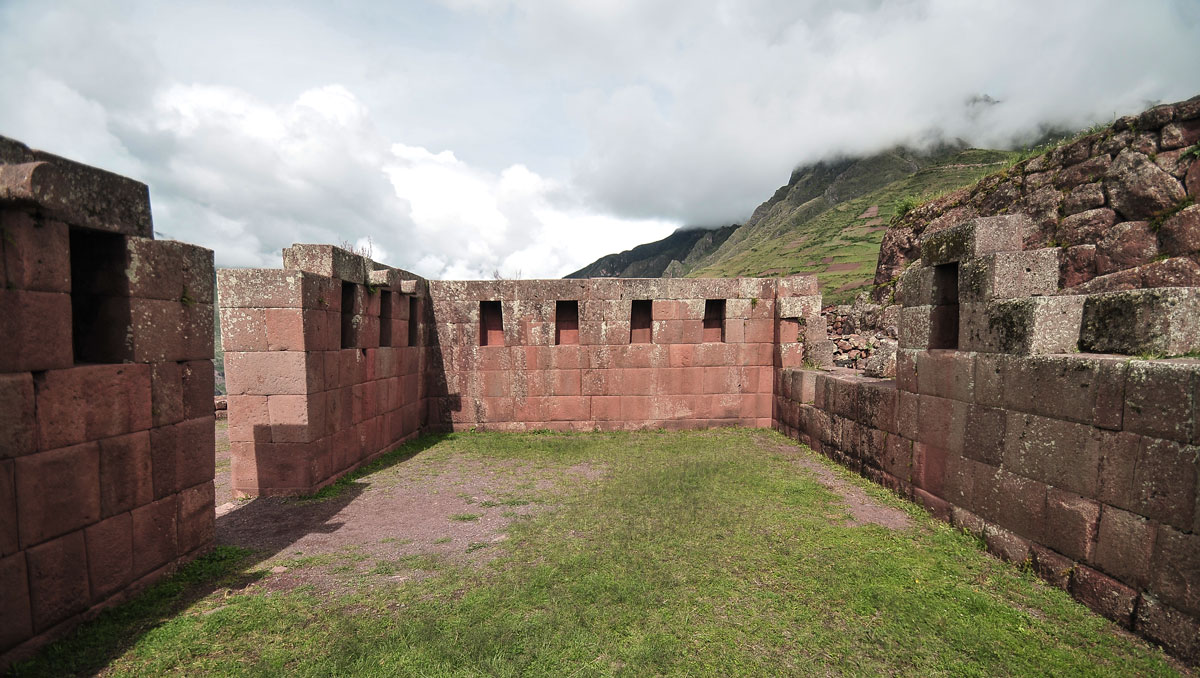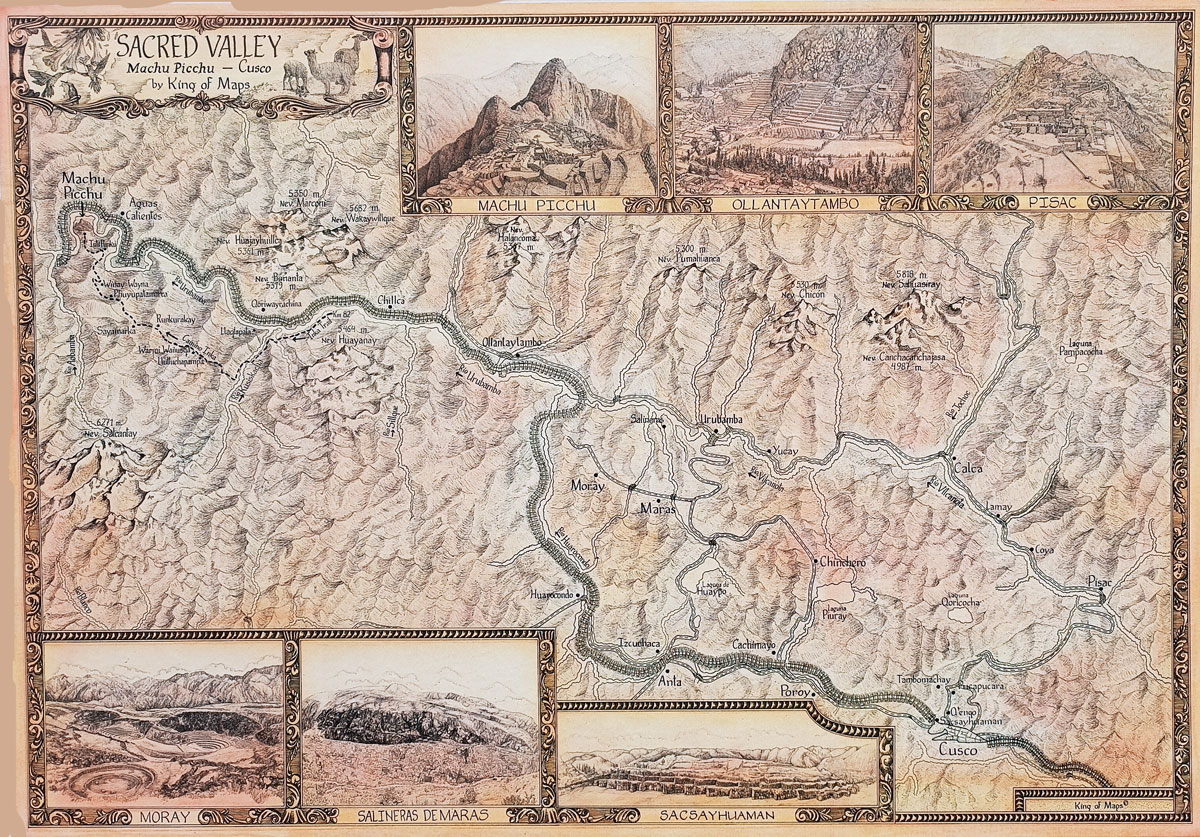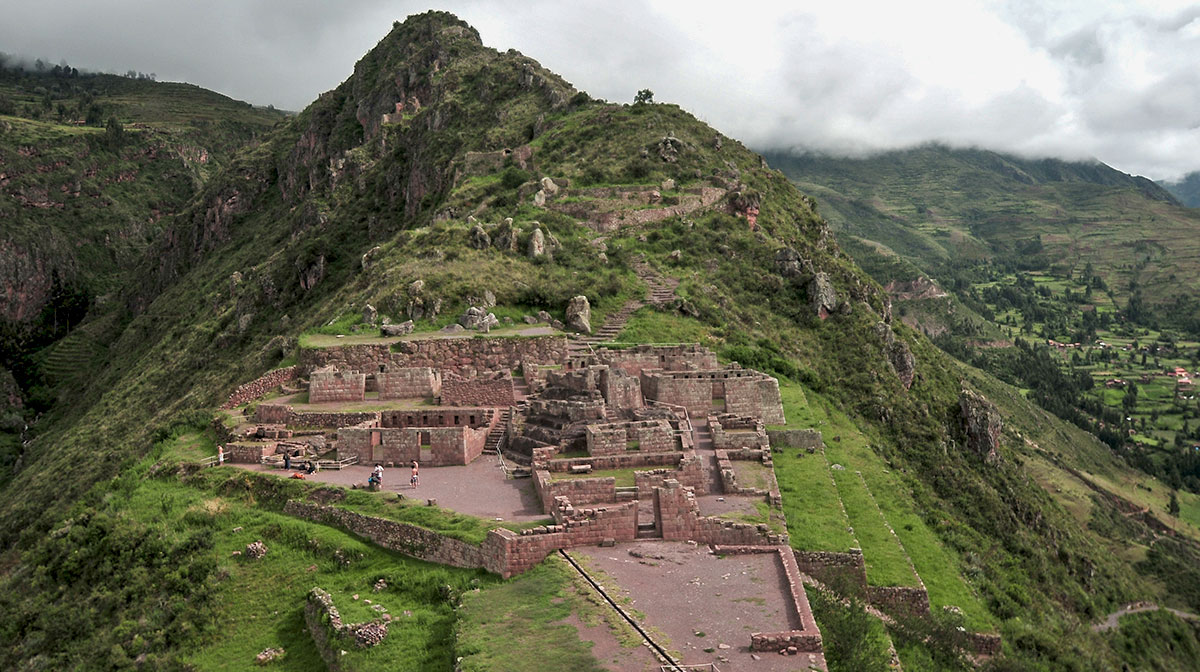Pisac is a town in Cusco – Peru, famous for hosting the Inca archaeological site of the same name. Its ruins attract thousands of visitors who visit the tour of the Sacred Valley of the Incas. It is recognized for its platform system and its carved stone enclosures.
Pisac has a lot of tourist attractions, that make this destination a mandatory stop point in the Sacred Valley.
The town of Pisac is surrounded by beautiful mountains. There are a lot of things to do in Pisac town, like enjoy nature as well as its plaza and church.
Where is Pisac – Peru?
Maybe you are asking where is Pisac Peru? Well, the Pisac Village is located at the eastern end of the Sacred Valley of the Incas. The Pisac ruins is one of the best Inca archaeological complexes in Peru. They are located on the road along the side of the mountain, just behind the town.
Historical Review of Pisac in Cusco Peru
Millions of years ago, when the earth was formed with erupting volcanoes, the immense Vilcanota basin was formed where nature gave way to the lives of many beings, where 50 million years ago the ancestors of the flames would have inhabited, from of the findings in the year 1979, the existence of fossilized marine species such as: brachiopods, bryozoa, gastropods, corals, seaweeds, among others, the cave paintings of the caves of Chahuaytire located at 3900 meters above sea level. , show that the first settlers of the Pisac Valley lived, dating back 5000 years BC, who were dedicated to hunting and gathering food and starting an incipient agriculture based on the cultivation of Andean tubers, in addition to the domestication of South American camelids as: The flame.

One of the great contributions to the development of Andean culture are the agricultural, artisanal activities and the construction of buildings, these achievements served for the survival in time of food shortages, the alpaca fiber and the wool of the llama began to make their clothing, giving way to the development of textiles, according to several chroniclers, around 1050 Manco Capac conquered and reduced several leagues northeast of Cusco, including the Ancasmarcas and Calcas, where Pisac geographically forms this cardinal point, the Inca city of Pisac located on the mountain of the Apu Inti Huatana hill and its surroundings are scattered by the topography of the area but reasonably interrelated by functionality, presenting characteristics of the sociopolitical organization of the Andean world such as the duality between the sectors Anansaya and Urinsaya, can be distinguished today is the Inca acropolis, from the part and high we have the sectors of QanchisRoaqy, Qantus Rocay, Antanamarca or "Inca Cemetery", Amaru Punku or "Portal of the serpent", Kallakasa, Pucara, the Inti Huatana, the colcas, Pisaca, it has the shape of an extinct bird in the that its construction would have been based, at the bottom of this is a series of platforms that lead very close to the Chunqumayo stream, these platforms were like a botanical laboratory whose name is Qoskanapata.
At the foot of the Inti Huatana mountain are the agricultural terraces with an irrigation system that cover the entire extension of Pata Pata where agricultural, hydraulic and architectural engineering stands out, it is here that the current town of Pisac emerged, from the time of the colony with the reductions that the Viceroy Toledo implanted, we can still appreciate colonial buildings such as the Pata Calle chapel, the colonial temple, the cross and the main cazones of the Marín families among others, between the colonial era the rebellion of the Pisac chief "Don Bernardo Tampo Huacso Pumayali" in the year 1777, in the colonial period a series of economic, political and social cultural manifestations began to take place, such as religiosity, which over time was consolidated as a tradition in the population to this day, ancient and ancient customs still persist.
Elevation of Pisac Peru
The colorful town of Pisac in Cusco Peru is located 33 km from the City of Cusco and the elevation of Pisac Peru is almost 2,972 meters above sea level (9,751ft). The elevation of Pisac ruins in Perú is 3,300 meters above sea level

Weather in Pisac Peru
During the year two seasons are observed: in winter (from April to September) the temperatures oscillate between 2 ° and 20 ° C with a magnificent blue sky during the day and drop in temperature at night, in summer (from October to March) there are constant rains and the temperature varies between 7 ° and 21 ° C. Pisac is part of the Sacred Valley of the Incas, so the weather in Pisac Peru is usually temperate during most of the year, with some ups and downs during certain periods.
During the course of the year, the temperature generally varies from -0 ° C to 18 ° C and rarely drops below -3 ° C or rises above 21 ° C.

The best time of year to visit the Pisac Village
The best times of year to visit the Pisac Village is from the beginning of May to the beginning of June and from mid-July to the end of September, with the best weather in Pisac Peru during the last week of August.
How to get to Pisac Village?
Pisac Village is 1 hour from the city of Cusco by road (34 kilometers). It is reached by the road that leads to Sacsayhuamán. Public transport buses are taken on Puputi street in the Historic Center of Cusco.
Things to do in Pisac
The main festivities in Pisac Village are:
The festivity of the Virgen del Carmen, this festivity lasts 4 days, the first day is characterized by the running of horses and the burning of castles, the following day is the central one where the mass stands out, the procession of the Virgen del Carmen and the parade of folk dances, a day later the dances show their excitement and elegance towards national and foreign visitors and finally the Cacharpari, represents the farewell of the party sharing the snack or "Chiriuchu" among all participants, in addition highlights the "Maqtwarkuy" execution to the peasant, the "Pampanakuy" representing the burial of authorities and people very welcome to the people and finally the Occa Tarpuy, concluding the party with the final dance "Ocaswa"
One of the main ancestral customs are the carnivals that represent the fertility of the land and the beings that inhabit it, love, joy and fertility, as well as tours of recognition of the border lines between the communities such as festive borders such as In the case of ChillChiyani, of all these manifestations it is worth noting the local gastronomy that today we can find in the typical Pisac market or Sunday fairs with a variety of typical Andean and colonial dishes such as Chiri uchú, roasted guinea pig, capchi de broad beans, bachelor, yuyuhaucha, escabeche, scrambled eggs, suckling pig, roast duck, among others, also drinks such as chicha, frutillada; the making of wheat bread or chuta, this in the colonial oven of San Francisco, the main economic activity of Pisac is the crafts that have been carried out since ancient times, as well as ceramics, textiles, among others that are sold in the traditional fairs of the Pisac market, known and visited all over the world, the Chahuaytire community is the most representative in the Pisac Valley, the fabrics that this community dominates from its ancestors intact the ancestral technique and iconography that today in a way Organized show their art to the world from their own community, our town of Pisac poses a challenge for the future of the new generations, to establish a city that preserves its cultural identity based on the principles of our ancestors, today with the support of our country and our brothers from all over the world, our enigmatic and eternal archaeological park of Pisac Peru, the inti Huatana, after the Historic Sanctuary of Machu Picchu, is recognized as a wonder of Peru and the world.
Another things to do in Pisac include to visit several tourist attractions:
The town of Pisac
The town of Pisac is surrounded by beautiful mountains. There are a lot of things to do in Pisac town, like enjoy nature as well as its plaza and church.

Pisac Market in Cusco Peru
The traditional Pisac market in Cusco Peru was a very important commercial place centuries ago. Today, it is crowded by tourists, especially on Sundays.
The colorful Pisac market in Cusco Peru offers handicrafts, textiles, ceramics, and jewelry. You can't miss the textiles; Look for women from the Andean communities who sell their unique fabrics made from natural plants.
The fabrics of the Amaru and Chaihuatiri communities are especially fine and recognized worldwide, worthy collectibles. Písac is known for its hand-painted ceramics: plates, ashtrays, tea sets, and chess sets. Many local people still paint the intricate geometric Inca figures in their family workshops. You will find these works of art also in wood, to prevent them from breaking.
The opening days of Pisac market are sundays, and also this is the most festive day, since the inhabitants of the high Andean communities go down to the town with their traditional clothes to sell or exchange their precious agricultural products. The varayoc (authorities) of the ayllus (communities) walk through the town with their ponchos blowing their pututos, which gives the Sunday holiday a distinctive touch.
Apu Runawana Weavers Association
Amaru is one of the 13 indigenous communities in Písac and is home to the Apu Runawana Weavers Association, made up of a group of indigenous people who consciously preserve and practice their traditional lifestyle and values. Experience this culture up close and learn about the importance of weaving and agriculture for Andean calendar celebrations. The community also offers a hike to the Sacred Lakes - an unforgettable hike in the Andes for experienced explorers at altitude.
The Pisac Archaeological Site
The most attractive tourist attraction in Pisac. It has Inca remains as important as Machu Picchu as the Temple of the Sun.
At the Pisac Archaeological Site, science, agriculture and ceremonies were developed, all these activities intertwined with the reality of everyday life. The archaeological site also served as a ceremonial center to celebrate and honor these cosmic moments.
Stonework is considered one of the finest in the valley and is admired for the architectural skills of its construction. It has the largest pre-Columbian cemetery in the Americas: 11 miles of slopes with approximately 400,000 traditional graves. Unfortunately, most of the graves were looted.
In the Pisac Archaeological Site, in addition to overlapping terraces, you will find ceremonial baths, a residential settlement and the largest Inca cemetery (the oldest in South America).
Down the mountain, you will find the temple complex exquisitely carved from granite. There are ceremonial altars, water wells and the beautiful Inca Temple of the Sun.
These are the Archaeological Sites of Pisac:
Acchapata Group of Platforms
Just 200 meters up from the town square of Pisac Inca Ruins a beautiful set of platforms rises. This group is made up of 40 platforms forming a kind of triangle with a vertex downwards, that is, the smallest platform is the first one that the visitor can see when he begins to ascend.
Torreones or Pucaras
In the Pisac Inca Ruins we can count more than twenty towers and they are of two types: the towers and the watchtowers; the former are conical enclosures associated with construction water channels with well-carved and assembled parts, these look like pulpits attached to the mountain. The watchtowers are beautiful elevations, with a conical tendency, they are not enclosures, their texture is solid and their interior has a compact mass and their portion is a flat surface. In total there are more than 20 towers. Some are attached to the mountain. The rest are compact mass elevations. The most important in its location is Qoriwayrachina.
Intiwatana neighborhood
It is the central neighborhood, home to temples and palaces, with a higher architectural quality, greater beauty in its walls, the venues are larger in relation to those of other neighborhoods. It has 3 levels to gain aesthetics and comfort, they modulated the buildings directed towards the main valley. In this place we can find: The central enclosure, the Intiwatana, the altar carved out in a volcanic gap, groupings of liturgical sources, alleys and courtyards.
Tianayuc neighborhood
It is known as Tianayuc which translates to “having a seat” since in the interior patio there is a kind of sofa for two people, with a backrest and elbow pads made of stone. This neighborhood is small, with rooms whose doors open onto a central courtyard, plus an almost destroyed tower that dominates much of the K’itamayu gorge.
K’allaQ’asa neighborhood
It is the largest of the neighborhoods of the Pisac Inca Ruins, built on the top of the mountain the highest altitude of all the enclosures, its enclosures move on a sloping plane descending to the North. It has many rooms, steep slopes, turrets, a short tunnel 3 meters long; this neighborhood has impressive ravines on its sides.
Pisaq’a neighborhood
It is on the Chongo gorge, two hundred meters away from the Intiwatana neighborhood and at a lower height. This neighborhood was built by lowering the original level of the ground to modulate a plain. The plan of this neighborhood is semicircular obeying the shape of the mountain, this set consists of 23 rooms built with amazing order.
QanchisRaqay neighborhood
This neighborhood has many constructions, the houses are made of medium and small stones, the plan of the set is inclined, reaching the slope where the Chongo stream is. The entire neighborhood is like a sentinel controlling the northeast side of the city of Pisac.
How to visit Pisac?
You can visit Pisac in 3 ways:
- Hiring the services of a tour to the Sacred Valley of the Incas, which includes admission to the ruins of Pisac.
- Buying the Tourist Ticket of Cusco in its offices located in the AV. El Sol. I can buy the full ticket or a partial one.
- Buying the ticket at the door of the same archaeological site of Pisac.
Tour to the Sacred Valley of the Incas
Known to the Incas as Willcamayu, the beautiful Sacred Valley of the Incas stretches from the town of Pisac to Ollantaytambo, along the Urubamba River. The ancient Inca settlements in these cities are presented as checkpoints, before entering the "Inca trail" that leads to the sacred city: Machu Picchu.
The Sacred Valley Tour is a markedly traditional route, where the visitor will meet Quechua-speaking residents, in typical costumes, working in their fields in an artisanal way, passing through villages built in colonial times and through ancient settlements Inca. It will visit markets, temples and city squares. It is important to note that the Sacred Valley of the Incas is made up of Pisac, Urubamba, Ollantaytambo, Chinchero, Maras, Moray and Yucay.

Tour on your own
It can be reached through an agency on a tour of the entire Sacred Valley. You can also use the public transport that goes to Urubamba that leaves every 15 minutes, you must get off the bridge and from there you must go to the back of the Pisac temple in a walk of more or less an hour.
- By taxi: it is the most comfortable and fastest way to get there, but also the most expensive.
- By local bus: it is the slowest method of getting there because depending on which you take, it will make many stops.
- By van or van: it is little more expensive than the local bus but much faster and we believe that the best option for value for money (4-5 soles)
If you go by bus or van from Cuzco, it will let you just past the metal bridge that gives access to Pisac, near the taxi rank.
How much does the entrance to Pisac cost?
The Cusco Tourist Ticket is the cheapest way to visit Pisac because it also includes many other archaeological sites:
- General tourist ticket: S /. 130.
- Partial tourist ticket: S /. 70.
What are the hours of operation in Pisac?
From 7 a.m. until 6 pm. He attends every day of the week. The cost of admission is included in the Tourist Ticket.
When is the best time to go to Pisac?
The dry season (April to October) is the best time to visit Pisac. During those months there is less chance of rain making the excursion easier. It is recommended to make the visit in the early hours of the morning.
Tips for visiting Pisac
- Bring a bottle of water before and during the walk.
- It is recommended to use hiking shoes. That way you will avoid twists and accidents.
- Bring a rain poncho with you. It is not known when the river precipitation will occur.
- The day is hot so it is advisable to wear a hat, sunscreen and sunglasses.
- The best way to understand Pisac is with the company of a tour guide. Tours include this service. Another option is to hire one at the entrance door.
Where to sleep in Pisac?
Despite its small size, there are some accommodations. However, we, for the comfort of not having to move luggage, believe that it is better to make a day trip with a start and end in Cuzco.
Other Treks in the Sacred Valley
- 4 day Inca Trail Tour
- 2 day Inca Trail
- Machu Picchu 3 day hike
- 2 day Inca Trail with camping
- One day Inca Trail
- Lares Trek to Machu Picchu







